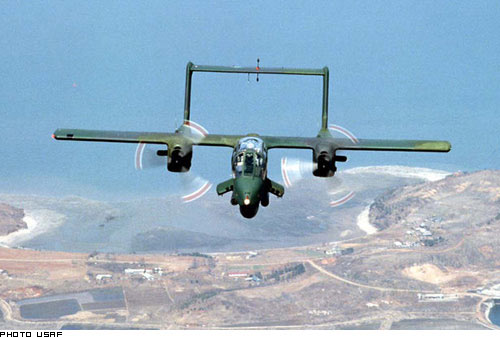OV-10 Bronco
Summary
| Category | Combat Aircraft |
| Origin country | 🇺🇸 United States |
| Manufacturer | North American |
| First flight | 16 July 1965 |
| Year introduced | 1967 |
| Number produced | 360 units |
| Average unit price | $1 million |
Description
The North American Rockwell OV-10 Bronco was conceived in the early 1960s. Through an informal collaboration, the concept was for an aircraft able to operate from expedient forward air bases using roads as runways, with speed ranging from very slow to medium subsonic, and with long loiter times. The U.S. Navy, Air Force, and Army approved a tri-service specification for the Light Armed Reconnaissance Aircraft (LARA), issuing it in late 1963 for a versatile, light attack and observation aircraft. Eleven proposals were submitted, and in August 1964, the North American Aviation/Rockwell NA-300 was selected, leading to a contract for seven prototype aircraft in October 1964. The Bronco started flying on 16 July 1965, and became a counter-insurgency aircraft.
The OV-10 has a central nacelle containing pilots and cargo, and twin booms containing twin turboprop engines. The visually distinctive feature of the aircraft is the combination of the twin booms with the horizontal stabilizer that connects them. The bottom of the fuselage bore sponsons that improved flight performance by decreasing aerodynamic drag underneath the fuselage. Four 7.62 mm M60C machine guns were normally carried on the sponsons, accessed through a large forward-opening hatch on the top of each sponson. The sponsons also had four racks to carry bombs, pods, or fuel, while the wings outboard of the engines contained two additional racks, one per side. The total external munitions payload is 3,200 lb (1,450 kg). Racked armament often included seven-shot 2.75 in (70 mm) rocket pods with white phosphorus marker rounds or high-explosive rockets, or 5 in (127 mm) four-shot Zuni rocket pods. Bombs, ADSIDS air-delivered unattended seismic sensors, Mk-6 battlefield illumination flares, and other stores were also carried. Some variants were equipped with a 20 mm XM197 electric cannon. North American Rockwell custom ejection seats were standard, and the cockpit offered notable visibility for a tandem pilot and co-pilot, provided by a wrap-around greenhouse that was wider than the fuselage. With the second seat removed, it can carry 3,200 pounds (1,500 kg) of cargo, five paratroopers, or two litter patients and an attendant.
The OV-10 saw service in the U.S. Air Force, Marine Corps, and Navy, as well as several other nations. The Marine Corps initially acquired the OV-10, with each of its two observation squadrons (VMO) equipped with 18 aircraft, operating as forward air controllers (FAC); they were phased out in 1995 after Operation Desert Storm. The USAF primarily used the Bronco as an FAC aircraft, with initial combat deployments to Vietnam in 1968 to evaluate its capabilities in strike direction, reconnaissance, and artillery direction. Between 1968 and 1971, Royal Australian Air Force and Royal New Zealand Air Force pilots flew the OV-10A on FAC sorties while attached to USAF squadrons. The U.S. Navy formed Light Attack Squadron Four (VAL-4), operating the OV-10A in Vietnam for light ground-attack missions, logistics interdiction, and fire support, though the squadron was decommissioned after the war's end. The USAF provided Colombia with 12 OV-10As in 1991 for counter-insurgency (COIN) operations. The Indonesian Air Force purchased 16 OV-10F aircraft in 1976, employing them in a COIN role; they were deployed to East Timor, where two were lost in non-combat accidents. The Royal Moroccan Air Force acquired six OV-10As in 1981, employing them in COIN operations against Polisario forces in the Western Sahara War. The Philippine Air Force received 24 OV-10As in 1991 and utilized them for search-and-rescue and COIN operations, which have been used in air strikes against Moro Islamic Liberation Front.
Main Variants:
-
OV-10A: The original production version, equipped with enlarged wings and 715 shp T76-G-10/12 engines, distinguishable by a long-wire high frequency (HF) antenna.
-
OV-10B: A target towing variant produced for Germany, featuring a target towing pod mounted beneath the fuselage and a clear dome replacing the rear cargo door.
-
OV-10C: An export version of the OV-10A built for Thailand.
-
OV-10D: A second-generation Bronco developed under the NOGS program, with a forward-looking infrared night-vision system, a turret-mounted camera, bigger engines, and larger fiberglass propellers.
-
OV-10F: An export version of the OV-10A built for Indonesia.
Technical specifications
| Version: OV-10A | |
|---|---|
| Crew | 1 pilot + 1 observer |
| Operational range | 360 km (224 mi) |
| Maximum speed | 452 km/h (281 mph) |
| Wing area | 88.7 m² (954.7 sqft) |
| Wingspan | 12.2 m (40.0 ft) |
| Height | 4.6 m (15.1 ft) |
| Length | 12.7 m (41.7 ft) |
| Service ceiling | 8,780 m (28,806 ft) |
| Empty weight | 3,261 kg (7,189 lbs) |
| Max. takeoff weight | 6,552 kg (14,445 lbs) |
| Powerplant | 2 x turboprops Garrett T76-G-412 delivering 533 kW each |
| Ejection seat | North American LW-3B |
Current operating countries
| Country | Units | ||
|---|---|---|---|

|
Philippines | 7 | |
All operators
Armament
Missiles payload:
- Air-to-Air Short-Range Raytheon AIM-9 Sidewinder
